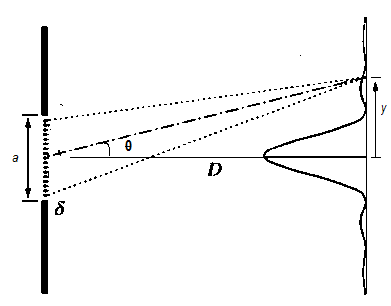
State with reason, how the linear width of central maximum will be affected if
(i) Monochromatic yellow light is replaced with red light, and
(ii) Distance between the slit and the screen is increased.
Answer
478.5k+ views
Hint: In a single slit diffraction, the light bends around the edge of the obstacles to form a diffraction pattern which consists of maxima and minima. Maxima are those with bright spots and minima are those with dark spots. Here central maximum is the central bright spot or the first bright spot in the pattern.
Formula used:
Linear width of central maximum, \[{{\beta }_{0}}=\dfrac{2\lambda D}{a}\]
Complete answer:
Diffraction is a phenomenon which shows the wave nature of light, as we know that light has dual nature of particle and wave, when the light source faces an obstacles in path it bends around the corners of the obstacles. We can observe this in our daily life too, for example the shadow made by any object.
In a single slit diffraction, the light source is passed through the slit whose width is nearly the order of the wavelength of the light source. So, when light is passed through a slit, we get a diffraction pattern on a screen, which is kept at a few cm or m away from the slit. The diffraction pattern and the arrangement can be understood by the given diagram

From the diagram we can derive,
\[a\sin \theta =\lambda \] and \[\tan \theta =\dfrac{y}{D}\]
Where λ, is the wavelength of the light source. As θ is very small nearly order of the wavelength
\[\theta =\dfrac{\lambda }{a}\] and \[\theta =\dfrac{y}{D}\]
We can equate the both equation, therefore it becomes
\[\begin{align}
& \Rightarrow \dfrac{y}{D}=\dfrac{\lambda }{a} \\
& \Rightarrow y=\dfrac{\lambda D}{a} \\
\end{align}\]
Linear width of central maximum is the twice of y we can also observe from the diagram,
\[\Rightarrow {{\beta }_{0}}=2y\]
Where, \[{{\beta }_{0}}\]is the linear width of the central maximum.
\[\Rightarrow {{\beta }_{0}}=\dfrac{2\lambda D}{a}\]
From the above equation we can conclude that the linear width of central maximum is directly proportional to the wavelength and the distance between the slit and the screen.
Therefore, (i) the linear width will increase if the monochromatic yellow light is replaced with red light because red light has a larger wavelength than yellow. (ii) Similarly with the increase of distance between the screen and the slit the linear width of the central maximum will increase.
Note:
The wavelength of the red light is greater than yellow light and its frequency is less than the yellow light, many of us get confused by it and can make mistakes. Similarly one can get confused between angular width and the linear width. Angular width is given as 2θ and linear width is 2y.
Formula used:
Linear width of central maximum, \[{{\beta }_{0}}=\dfrac{2\lambda D}{a}\]
Complete answer:
Diffraction is a phenomenon which shows the wave nature of light, as we know that light has dual nature of particle and wave, when the light source faces an obstacles in path it bends around the corners of the obstacles. We can observe this in our daily life too, for example the shadow made by any object.
In a single slit diffraction, the light source is passed through the slit whose width is nearly the order of the wavelength of the light source. So, when light is passed through a slit, we get a diffraction pattern on a screen, which is kept at a few cm or m away from the slit. The diffraction pattern and the arrangement can be understood by the given diagram

From the diagram we can derive,
\[a\sin \theta =\lambda \] and \[\tan \theta =\dfrac{y}{D}\]
Where λ, is the wavelength of the light source. As θ is very small nearly order of the wavelength
\[\theta =\dfrac{\lambda }{a}\] and \[\theta =\dfrac{y}{D}\]
We can equate the both equation, therefore it becomes
\[\begin{align}
& \Rightarrow \dfrac{y}{D}=\dfrac{\lambda }{a} \\
& \Rightarrow y=\dfrac{\lambda D}{a} \\
\end{align}\]
Linear width of central maximum is the twice of y we can also observe from the diagram,
\[\Rightarrow {{\beta }_{0}}=2y\]
Where, \[{{\beta }_{0}}\]is the linear width of the central maximum.
\[\Rightarrow {{\beta }_{0}}=\dfrac{2\lambda D}{a}\]
From the above equation we can conclude that the linear width of central maximum is directly proportional to the wavelength and the distance between the slit and the screen.
Therefore, (i) the linear width will increase if the monochromatic yellow light is replaced with red light because red light has a larger wavelength than yellow. (ii) Similarly with the increase of distance between the screen and the slit the linear width of the central maximum will increase.
Note:
The wavelength of the red light is greater than yellow light and its frequency is less than the yellow light, many of us get confused by it and can make mistakes. Similarly one can get confused between angular width and the linear width. Angular width is given as 2θ and linear width is 2y.
Recently Updated Pages
Using the following information to help you answer class 12 chemistry CBSE

Full Form of IASDMIPSIFSIRSPOLICE class 7 social science CBSE

In case of conflict between fundamental rights of citizens class 7 social science CBSE

Can anyone list 10 advantages and disadvantages of friction

What are the Components of Financial System?

Complete the letter given below written to your Principal class null english null

Trending doubts
Show variation of resistivity of copper as a function class 12 physics CBSE

Electrolysis of dilute H2SO4 generates H2S2O8 What class 12 chemistry CBSE

Explain with a neat labelled diagram the TS of mammalian class 12 biology CBSE

How do you convert from joules to electron volts class 12 physics CBSE

A convex lens is placed in water Its focal length A class 12 physics CBSE

Distinguish between asexual and sexual reproduction class 12 biology CBSE




